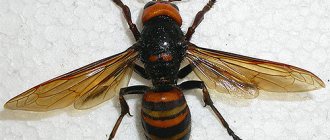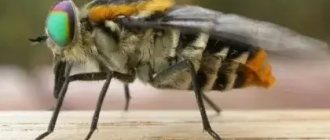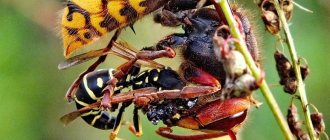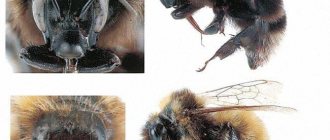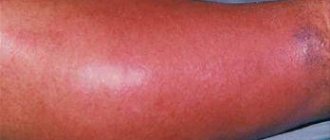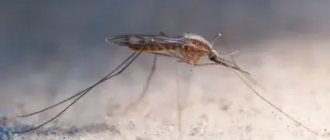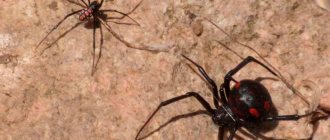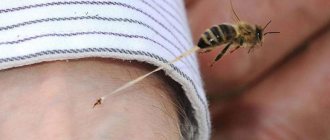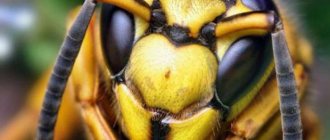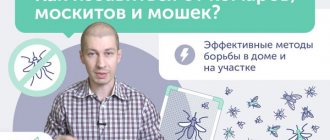A menacing buzzing makes many people anxious, and if something similar to a hornets’ nest appears in sight, there is a desire to get as far away from the dangerous place as possible. This is how people react to a potential threat. And this is correct, because the maximum risk of a bite occurs within a radius of 2–3 m from the nest.
Who is a hornet and why is it dangerous to humans? What to do if it bites and what could be the consequences? How to get rid of them and how do they differ from bees, wasps and bumblebees? Let's figure it out.
Who is the hornet
This is the largest representative of the so-called paper or social wasps. Their Latin name is Vespa, which literally translates as “wasp”. However, these are different insects that belong to the same family - true wasps.
Initially, no difference was made between the two representatives, and only in the 19th century the Vespa genus was divided into two groups. The description was based on several characteristics, but the main one was size - hornets are larger and can reach a length of up to 5.5 cm. Insects that are today considered wasps are designated in Latin as Vespula, that is, “small wasp.” Their size is 1.5–2 cm in length.
The hornet's threatening appearance is given by the bright coloring of its head - a combination of yellow, black, and orange.
The aggressive image is complemented by a striped belly, strong jaws and large eyes. However, these insects, unlike wasps, are non-aggressive. Human bites occur when a nest is disturbed or in self-defense.
Biological description
Hornets belong to the genus - social wasps. They live in families. A swarm can include up to several thousand individuals. Their life processes are clearly organized. Thus, within the “community” there are separate “castes” that perform specific functions.
The task of the hornet queen is to leave offspring. She is the leader of the colony. Females are born from fertilized eggs in August and September. Hornets reproduce by mating mature insects. After the females are fertilized, the males die.
The female stores sperm during the winter. With the onset of warm spring days, the queen begins to actively feed and regain strength in order to begin creating honeycombs for laying eggs. Thus, it forms the foundation of the future nest.
How long a hornet lives depends on its “profession”. Thus, males exist for one season, and the lifespan of the queen is a year.
The insect also has powerful jaws - mandibles. Literally speaking, hornets not only sting by injecting poison, but also bite. The insect uses mandibles to tear and grind prey.
During the active season, hornets feed on the juice of overripe fruits, trees, and honey. They hunt caterpillars, dragonflies, flies, spiders, related bees and wasps. They also cope with larger insects - crickets, locusts. There are descriptions of species capable of attacking birds and frogs. The prey is not used for food—the mass chewed and treated with saliva is used to feed the larvae.
Nests
The structure of a hornet's nest is based on hexagonal honeycombs.
The material is a substance similar to paper or cardboard. This is a lightweight structural element with thermal insulation properties of a brown color, which is obtained by mixing tree bark with insect saliva.
The place for the nest is chosen by the queen hornet. She does it where the offspring will be protected from excessive heat, cold and prying eyes.
Hornet nests reach 50–70 cm in length and are located in tree hollows, abandoned or used premises, cavities under roots, and piles of dead wood.
In the European Union, hornets are protected by law. For example, in Germany, the destruction of their nests is punishable by a large fine.
Area
Most species of hornets live in areas with a temperate climate, mainly in the northern hemisphere. Entomologists believe that they originally lived primarily in East Asia. There are several types of hornets on the territory of Eurasia, mainly the common and oriental ones.
People themselves play a major role in the spread of the insect. For example, a representative of the “common” species came to North America along with colonists from Europe in the middle of the 19th century.
In Russia, the hornet lives on a vast territory, which includes the European part of the Urals, Transbaikalia, the Amur region, and southern Sakhalin.
Kinds
Representatives of the extensive Vespa genus include more than 20 species.
- Affinis - small striped one.
- Analis - found in East Asia, measuring 25–28 mm.
- Basalis - basal.
- Bellicosa - warlike.
- Bicolor - two-color.
- Binghami - Binghama - active at night.
- Crabro - ordinary.
- Ducalis - commander's - one of the largest in Russia.
- Velutina is tropical, but also lives in Europe, as it was accidentally introduced there.
- Dybowskii - Dybovsky - almost monochromatic - black-brown.
- Fervida - ardent.
- Fumida - variable.
- Mandarinia is the largest in the world and also very poisonous.
- Multimaculata - multi-spotted.
- Orientalis - eastern.
- Philippinensis - Philippine.
- Luctuosa is tropical, found in the Philippines and is the most poisonous.
- Simillima - similar, very similar to the common hornet.
- Vivax - lives in Asia.
- Soror - black-tailed.
- Tropica - tropical.
Eight species of hornets live in Russia. The leader in occurrence is the “ordinary” (Vespa Crabro), which is distributed throughout almost the entire country, including the Moscow region. It is absent only in northern latitudes. The eastern hornet (Vespa Orientalis) lives in the Caucasus. In the south of the Far East, six species of Vespa are found - Simillima, Dybowskii, Ducalis, Mandarinia, Analis, Dinghami.
Role in nature
The benefits that hornets bring:
- destroy harmful insects that parasitize garden crops and wild plants - aphids, mites, psyllids;
- pollinate plants;
- They hunt locusts, flies, wasps, sick, “old” bees.
Natural enemies of hornets in nature limit their population within useful limits and destroy sick individuals. Among animals, these are ants, some species of birds (starlings, wagtails). Hornets are also susceptible to parasites - mites, nematodes, parasites and even microscopic fungi.
Interesting Facts
There are more than 20 species of hornets in the world, differing in color, behavioral characteristics, and size. The largest representative is the Asian one (Vespa Mandarinia), whose length exceeds 5 cm. In China, it is known as the “bee tiger”. Its venom contains a neurotoxin.
The hornet's queen releases pheromones that influence males. With their help, the “queen” organizes the activities of the entire swarm.
In the 18th century, the French naturalist, physicist and mathematician René Antoine Reaumur studied the material from which wasps build their nests. The result was a proposal to use wood in the production of paper, because until that moment, it was made from rags.
Origin of the species and description
Photo: Hornet
A large wasp whose flight is accompanied by a loud buzzing sound is a hornet. It is a prominent representative of the family of social wasps, often called the hornet wasp. In Latin, the name of the species sounds like “Vespa”. It is translated into Russian by the word “wasp”. Initially, all social wasps were classified in the genus Vespa. However, in the nineteenth century it was divided into two families. Hornets are still Vespa and wasps are still Vespula (little wasp).
Video: Hornet
The origin of the Russian name “hornet” is no less interesting. The root of this word, in turn, means head, horns. For this reason, scientists concluded that the hornet wasp received its name due to the anatomical features of the structure of the head. The animal has an enlarged crown and movable antennae.
To date, about twenty species of hornet wasps have been recorded. Vespa mandarinia is recognized as the largest species. Adult Vespa mandarinia can reach five and a half centimeters in length.
Among the various types of hornets, we can separately highlight the most interesting of them:
- black hornet. This is a little-known, rare species of social wasp. Listed in the Red Book due to rapid decline in population numbers. It has the characteristic color of a predator - yellow stripes on a black back;
- Asiatic. Quite a large species with a large wingspan. Lives in Asian territory. It carries a certain danger for humans. Its bite is highly toxic;
- Philippine. It is distinguished by its solid black color and produces dangerous poison. Lives exclusively in the Philippine Islands;
- Oriental. Of all the representatives of the genus, it has the brightest colors. Its belly is decorated with a wide yellow stripe, its body and wings are painted bright red. The species tolerates heat remarkably well and lives in steppes and even deserts.
Why is a hornet dangerous for humans?
The following components of the poison pose a danger to humans:
- phospholipase A2 is an enzyme that activates the inflammatory response;
- acetylcholine is a neurotransmitter that ensures the transmission of impulses;
- histamine is a mediator of immediate allergic reactions;
- mastoparan is a toxin of protein origin.
As a result of the influence of a “bouquet” of biologically active substances on the tissues of the human body, a protective systemic inflammatory response develops.
A hornet sting can be fatal to humans if the victim experiences an allergic reaction. The following complications may also develop:
- skin rashes;
- bronchospasm - obstruction of the airways with difficulty exhaling;
- hallucinations;
- paroxysmal pain in various parts of the abdomen, nausea, vomiting;
- convulsive syndrome;
- depression of consciousness;
- a sharp decrease in blood pressure with further cessation of blood circulation.
Single hornet bites during pregnancy and lactation do not pose a danger to the fetus and infant, since the amount of poison is insignificant to penetrate the placental barrier or into the liver of a nursing mother.
How dangerous is a hornet bite for a child? Due to the small body weight, the concentration of poison for his body is very high, so the symptoms are more pronounced. And also due to the fact that children react actively and unpredictably to buzzing insects, the risk of multiple attacks increases, increasing the development of allergic reactions. In order not to risk the child’s life if bitten, you should immediately call an ambulance, without waiting for allergies to appear and anaphylactic shock to develop.
Hornet venom and its effect on the body
The poisonous substance injected by the hornet under the skin of the victim is protective in nature, which explains the painfulness of the bite. The components that make up the poison are found in rattlesnakes and other representatives of the animal world. The most dangerous components include:
- Acetylcholine. Activates nerve endings. Once in the tissue, it leads to irritation of nerve nodes, the occurrence of impulses and severe pain in the affected area.
- Phospholipase A2. A combination of enzymes that destroy cell walls. This substance is similar to a component of snake venom. Leads to vascular damage, hemorrhage, and the formation of suppuration.
- Orientotoxin. Dissolves cell membranes, allowing their contents to exit into the intercellular space. Destroys cellular structures.
- Histamine. Activates a rapid allergic reaction.
- Mastoparan. Releases histamine.
- Mandorotoxin. Blocks the functions of the nervous system.
- Biogenic amines. They provoke disruptions in the functioning of the respiratory and cardiovascular systems. Cause arrhythmia and difficulty breathing.
The remaining components act as catalysts, enhancing the reaction of tissues, accelerating the process of distribution of toxic substances.
Causes of a hornet sting
The main reason for a hornet bite is self-defense, and it always tries to get away from a person first and stings only if it is grabbed.
The insect uses its sting only for the purpose of protection or to neutralize a resisting victim. Entomologists explain that hornets will not consume poison without justified biological expediency. After all, this is a valuable weapon that is necessary during hunting.
Having detected a threat, hornets release alarm pheromones, which call on other individuals to attack. Therefore, everyone who is within a radius of 2–3 meters from a disturbed nest or a killed hornet will be bitten.
Myths and reality
There are many frightening myths about very “dangerous” hornets:
- attack without reason;
- the bite is very painful;
- the hornet has 9 stings;
- the poison from seven bites is enough to kill a horse;
- three bites are enough to kill a person;
- The venom is much stronger than bee venom and affects the entire body.
There are quite enough frightening facts to make you try your best to avoid the hornet and destroy its nest. But these points will have to be considered separately and in detail.
Attacks
As a social, nest-building insect, the largest wasp, as the hornet is often called, considers protecting its home and offspring a natural response to threat. A person often does not notice hornet honeycombs hidden in a secluded place and believes that the aggression was causeless. One has only to step back a couple of steps from the nest and the attacks will immediately stop. Even a reaction to an irritating odor will only occur near the nesting site. In any other place, the hornet wasp will simply fly away. Conclusion: the hornets had a reason for stinging. If possible, representatives of this genus prefer to flee rather than attack. The wasp and the hornet are different insects, although there are similarities between them.
On a note!
If you press the hornet, it will also sting.
Painful bite
Insect bite
The myth is based on the size of the insect: the larger the insect, the more painful the hornet stings. The statement is partially true. The painfulness of a European hornet sting on the Schmidt scale is on par with a honey bee sting. Polistinae and Pepsis wasps sting more painfully. But the bite of an Asian hornet will be more painful due to the size of the insect. The hornet's sting matches the size of the insect and penetrates deeper than the bee's sting. This circumstance adds thrill.
Number of stings
You can find out how many stings a hornet has on your own. All you have to do is slam one and take a close look. There is a myth that these wasp species can sting repeatedly because they have 9 stingers. Where do they hide these stings, one wonders.
On a note!
In fact, like everyone else, the hornet has only one sting. But it is smooth and does not get stuck in human skin. This means that this is a reusable weapon.
Degree of toxicity
Much depends on the size of the insect. The larger the wasp, the more poison it can release per bite. The myth about killing a horse or a person is only partly true. But here it is not so important how many times a bee, wasp, hornet, bumblebee stings. It matters where they sting.
Important!
The general rule is: the closer to the brain the bite was made, the more dangerous the situation.
Horses are more sensitive to insect poisons than humans, but it is impossible to kill them with seven doses into the thigh or back muscle. But if you are “lucky” to get poison into the jugular vein or into the oral cavity, the death of the animal is almost guaranteed. You can try to save a person.
Bite symptoms
The hornet does not leave a sting when it bites, so it can sting several times. This feature distinguishes it from bees. A large number of bites can be fatal to humans. Especially if you are allergic to wasp venom.
Symptoms that develop from a hornet bite:
- sharp, severe pain;
- swelling, redness;
- itching, burning at the bite site;
- increase in body temperature to high numbers;
- possibly manifestations of allergic reactions, including anaphylactic shock.
Population and species status
Photo: Hornet animal
The genus of hornets is quite wide. It includes more than twenty different species of insects, differing in color, size, feeding habits and lifestyle. Due to the presence of several species and high fertility, this genus is not endangered and is not listed in the Red Book.
The general population of hornets does not cause concern among scientists. It is normal, causes the least concern, and has a low risk of extinction. However, if we consider the hornet wasp population in terms of individual species, the situation is not so encouraging. Many species are on the verge of extinction and are listed in the Red Books of individual states and cities. The reduction in the number of such animals is due to completely different reasons, which can be found out in the next section of the publication.
The common hornet is an endangered species. Its population in different regions of its natural habitat is very unstable. In particular, this variety is included in the Red Book of the Smolensk region. Also a small representative of the hornet genus is the Dybovsky hornet (black). It is of average size for hornets, has a black-brown color, and is a predator. The black hornet is included in the Red Book of the Chita region. Some species of hornets are included in the Red Books of Germany and many other European countries.
First aid
What to do if bitten by a hornet? It all depends on where and under what circumstances it happened. It is important to protect people from mass attacks. The biological instincts of insects are aimed at survival, which means protection from external invasions. If there is a nest within 2–3 m, you must immediately leave the danger area. When indoors, you should close the windows and make sure there are no insects.
If a hornet bite occurs, the algorithm for providing first aid at home should be as follows:
- examine the wound;
- if a sting remains, for example, after hitting an insect, then carefully remove it;
- do not try to squeeze out the poison;
- suck out the contents of the wound as quickly as possible;
- treat the bite site with an alcohol wipe or liquid;
- to relieve pain and swelling, apply “cold”;
- if there are indications, then take an antiallergic drug, for example, Suprastin or Tavegil.
When treating a hornet sting at home, it is important to continue to monitor the condition of the victim. If alarming symptoms appear, you should consult a doctor.
What to do if a hornet bites a child? The algorithm of actions for providing first aid is the same as for adults. Then you need to calm the baby down, distract him from the unpleasant incident and seek the advice of a medical specialist. Incorrect assessment of symptoms, potential complications, and self-medication can significantly worsen the child’s condition.
Why do some people think hornets don't have a sting?
If the insect is in a calm state, then the presence of a sting is almost impossible to notice. Because they have a distinctive coloration that warns others of danger, members of the colony can live without worries. They are not afraid of anyone and are one of the most dangerous predators - flies, grasshoppers, and spiders suffer from them. But they bring special problems to beekeepers, because when attacking a hive, they are capable of chewing through a couple of colonies of honey bees.
When flying out to “hunt”, they use strong jaws that help them cope with prey. If you have ever encountered a dangerous insect, you will definitely not forget the view from the large striped body, the large head with impressive eyes, and the sound of the buzzing of the porches. Their jaws can bite through a child's thin skin, causing severe pain.
But, of course, most often they use their sting for defense and attack. So they have a special structure of muscles, segments at the end of the abdomen, their sting can easily hide inside it and, if necessary, move out in a split second.
Treatment
In the International Classification of Diseases, Tenth Revision ICD-10, a hornet sting is designated by code W57 - stinging by non-venomous insects and arthropods.
There is no specific antidote for a hornet sting. Therefore, treatment includes the use of the following drugs:
- analgesic;
- antihistamine;
- antipyretic;
- decongestant.
If life-threatening complications develop, intensive therapy is carried out in the intensive care unit.
If a hornet bites you on the head, namely, in the area of the face or neck, swelling may develop that affects the airways. This condition threatens the life of the victim and requires treatment in a hospital. Airway obstruction is an indication for hospitalization in the intensive care unit. Intensive therapy includes the administration of glucocorticosteroids (hormones of the adrenal cortex), diuretics, and, if necessary, connection to a ventilator.
Consequences
- children;
- elderly and senile people;
- patients with a history of allergies, chronic diseases of the heart, blood vessels, and respiratory organs.
The severity of symptoms and the possibility of developing complications depends on the health status of the victim.
If there was no allergic reaction of the body, then the inflammation caused by the hornet sting goes away in a few days. This can be judged by the reduction in swelling, redness, and pain in the wound area.
The damaged area may itch for some time. How to relieve itching after a hornet bite? It is enough to apply cold. If this is one of the symptoms of an allergic reaction, then you should consult a doctor who will prescribe antihistamines.
Hornet nests
Although hornets have a “reusable” sting, they very rarely bite humans.
Hornets build their nests from a kind of paper, which they obtain by gnawing the bark on young birch branches. That is why their paper, unlike other types of paper, is not gray, but brownish. Hornet "communals" can be found in hollow trees, in caves, birdhouses, and on steep slopes. Initially, females build combs from several cells facing downwards. As the family grows, the next ones are suspended from the first cells, etc. Large nests can consist of 6 tiers, up to 0.5 m in diameter.
The construction of the nest begins in the spring by the queen, the main female, who mates with the drones (males). She also lays eggs.
How to get rid of hornets
Smells that repel them:
- soapy;
- essential oils contained in red hot pepper;
- aroma of mint, geranium, basil, wormwood;
- smoke.
If a hornet has flown into a room, it will explore the space in search of a way out until it finds one. Therefore, to get rid of it in a house or apartment, the best solution is to simply open the window wider and allow it to get out. If you try to catch it using a jar or vacuum cleaner, there is a chance of being bitten.
Remedies for hornets:
- insecticides - Get, "Medilis-Super", "Delta-Zone", aerosol from wasp nests Mosquitall;
- traps - Argus Garden, Swissinno Wasp Trap;
- smoke bombs - “Mukhoyar”, “Quiet Evening”, “FAS”, “City”;
- ultrasonic or acoustic insect repeller - EcoSniper LS-989, Sititek Flash, Grad Ultra 3D, Weitech WK-0180;
- insecticidal lamps - Well, Mo-El, Hilton.
What else are hornets afraid of? They are repelled by plants - basil, geranium, mint, lemon balm, wormwood, hanging red pepper pods. With their help, you can get rid of hornets in your garden, yard or attic of a private house. It is enough to plant or lay out dry plants near the nest and after a while the insects themselves will prefer to move to another place.
Do you know that:
- After the first frost, all working hornets, the queen and the males die.
- Fertilized females find shelter and hide in places protected from frost to overwinter. In the spring, new nest construction begins, and the life cycle repeats again.
- Only working females and the queen are armed with a sting. With one bite, insects can paralyze or kill the victim.
- Hornets, like wasps, have a straight and smooth sting, so they sting repeatedly. The bee genus (except for the queen), unlike hornets, has a disposable sting.
- Hornets are much larger than wasps. Despite this, they are less likely to sting people.
- Hornets often make their nests under the roofs of residential buildings or other buildings, which, naturally, can cause concern to residents, since the insects make terrible noise. And on the way to the nest they often fly into windows.
- Hornets only sting when they feel threatened. Therefore, if this insect approaches you, do not pay attention to it, do not wave your arms or try to drive it away.
- Hornets are very beneficial insects, as they destroy many pests, so they should be protected.
Difference from bee, wasp, bumblebee
| Wasp | Bee | Bumblebee | Hornet | |
| Size(cm) | 2,0–3,5 | 2,1–3,9 | 1,3–2,8 | Up to 5.5 |
| The structure of the sting | smooth | has jagged edges | smooth | smooth |
| Painful bite | The pain from a hornet sting is comparable in intensity to the sting of a wasp, bee or bumblebee. | |||
The hornet can also be confused with other insects.
- The gadfly is distinguished by its smaller size and color, which is dominated by gray and black shades. It belongs to synanthropic flies. Only one species attacks humans: the human skin botfly, which lives in Central America.
- The difference between Scolia and Hornet is in size. Its length is about 3 cm in females and 4.5 cm in males. There is also a difference in color - Scolia is almost all black, with only two yellow spots.
- A drone is a male honey bee. The difference from the hornet is in size (no more than 1.5–1.8 cm), less bright color and lack of a sting.
Let's summarize. The hornet is a large, brightly colored insect from the genus of social wasps. It has jaws and a sting hidden at the tip of the abdomen. People are bitten most often due to the instinct of self-preservation. This is facilitated by the fact that nests are often created in close proximity to human habitation. The consequences of a hornet sting are dangerous due to the appearance of an allergic reaction, with possible death from anaphylactic shock. Especially if the insect stung several times or a child, an elderly or senile person was injured. In this case, you should definitely seek professional medical help. If there was no allergy, then the inflammation goes away within a few days.
Tip size
Since the sting is the remains of a modified ovipositor, it is present only in female hunters. Males do not have such weapons and are absolutely harmless to large species of animals, but this does not make them any less dangerous to bees and those whom they consider future prey.
Ancient treatises that describe terrestrial animals claim fantastic facts - hornets can have a pair of stings, and their size ranges from small to large (several centimeters).
In reality, the sting is not so small in size - the most dangerous giant Asian hornet has a weapon of 1 centimeter. Common hornets, which are common in Russia, the USA, and Canada, their size is within four to six millimeters. In the photo you can carefully see what it looks like.
If you examine the sting under a microscope, you will notice 2 halves that are adjacent to one another. High magnification makes it possible to see that in bees it has the shape of a saw - there are jagged marks on the surface, but in hornets it is a dense tube created by durable chitin, the surface itself is hollow and smooth, the end is slightly pointed - this makes it possible to easily penetrate the skin victims.
When struck by an insect's sting, the muscle fibers located on the belly contract, resulting in a certain dose of poison entering the cavity of the “weapon.” All of us know what pain a syringe injection brings and what it feels like when medicine gets into the skin - the principle is the same when attacked by insects. But the pain experienced when bitten is not so much from the puncture of the skin, but from the influence of the poison.
